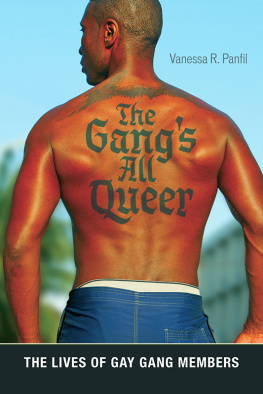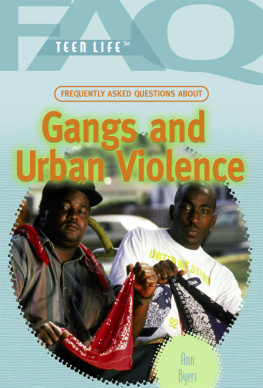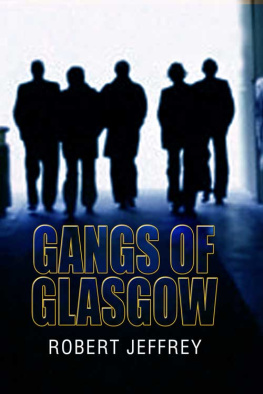Thank you for buying this ebook, published by NYU Press.
Sign up for our e-newsletters to receive information about forthcoming books, special discounts, and more!
Sign Up!
About NYU Press
A publisher of original scholarship since its founding in 1916, New York University Press Produces more than 100 new books each year, with a backlist of 3,000 titles in print. Working across the humanities and social sciences, NYU Press has award-winning lists in sociology, law, cultural and American studies, religion, American history, anthropology, politics, criminology, media and communication, literary studies, and psychology.
GANGSTERS
GANGSTERS
Fifty Years of Madness, Drugs, and Death on the Streets of America
LEWIS YABLONSKY
NEW YORK UNIVERSITY PRESS
New York and London
1997 by New York University
All rights reserved
Library of Congress Cataloging-in-Publication Data
Yablonsky, Lewis.
Gangsters : fifty years of madness, drugs, and death on the
streets of America / Lewis Yablonsky.
p. cm.
Includes bibliographical references and index.
Contents: The current gang problemGangs in the 20th century
Gang characteristicsBlack and chicano gangs : in and out of
prisonWhy gangs kill : the sociopath factorSome effective
interventionsThe therapeutic community approach to gangs
Varied theoretical viewpointsThe violent gang as a near-group
Joining a positive gang : a plan for treating gangsters in a
therapeutic community.
ISBN 0-8147-9679-6 (cloth : alk paper) ISBN 0-8147-9688-5 (pbk : alk.paper)
1. Gangs United States. 2. GangsUnited StatesPrevention.
I. Title.
HV6439.U5Y3 1997
302.34dc20 96-35713
CIP
New York University Press books are printed on acid-free paper,
and their binding materials are chosen for strength and durability.
Manufactured in the United States of America
10 9 8 7 6 5 4 3 2
Acknowledgments
MY PERSONAL AND PROFESSIONAL understanding of gangs has been influenced by many people. My brilliant and beloved son Mitch, a Los Angeles County probation officer, supported me throughout the travails of researching and writing this book, and pointed me in many useful directions for the acquisition of data. I am deeply grateful to my dear friends Norman Herman, Ben Krentzman, and Vince Jeffries, who listened with a feigned attentiveness that often bordered on sincerity to all of the good and bad concepts on gangs that I bounced off of them over the past several years, and on many occasions they contributed to my knowledge on the subject.
The L.A. County Probation Department was a vital source of data for my book. Barry Nidorf, Chief Probation Officer, paved the way for many of my interviews, and also provided me with an insightful analysis of the probation departments methodology for preventing, treating, and controlling gangs. Two probation officers, Jim Gallipeau, a thirty-year-veteran of the gang wars in South Central L.A. and Brad Carson, whose knowledge is based on his gang prevention efforts in Venice, helped me considerably in developing my overall perspective on gangs. I am also grateful to Ken Bell of the Los Angeles County district attorneys office and Peter Shutan of the Los Angeles city attorneys office for providing me with their valuable insights into the L.A. gang problem.
My dear friends and colleagues in the Amity Therapeutic Community provided me with a considerable amount of data on gangs in a variety of ways. The support of Amitys directors, Betty Fleishman, Naya Arbiter, and Rod Mullen, facilitated my entry into two of Amitys landmark prison programsthe California Department of Corrections Amity Right Turn Project in the R. J. Donavan San Diego Prison and the short-lived, but innovative, therapeutic community project in the Beaumont Texas Prison. Many Amity people helped me with my book personally and professionally. Notable in this positive gang of people was Elaine Abraham, Sheila Giddings, Fred Tent, Ernie Logan, Rachel Curtis, and Raymond Adame. Two special contributors to this project were two former L.A. Crips, my good friends Alex Pipkin and Demitrius McGee. My dear friend and colleague Zev Putterman, one of the most brilliant and intelligent ex-junkies on the planet, also contributed enormously to my viewpoint on several aspects of the gang problem.
Over the past forty-five years, several hundred active and former gangsters, in and out of prison, provided valuable data for the book. The platitude, without their help, this book would not have been written is literally true. I am most grateful for their cooperation in individual and group interviews, and their responses to questionnaires. Lena Lindsey and Jake Smotherman assisted me in the administration of the questionnaires.
My colleagues at Texas A & M UniversityCommerce, welcomed me into the Department of Sociology and Criminal Justice at a pivotal juncture in my sociological career and provided a pleasant and productive intellectual environment for the completion of this book. My special thanks go to Drs. Mathew Kanjirathinkal, Bill Thompson, Rock Clinton, and R. N. Singh and to President Jerry Morris. Randy McBroom, Jackie Harred, and Gregg Williford helped to analyze my gang questionnaires and contributed enormously to this aspect of the book.
Finally, and of importance, the enthusiastic acceptance of this project by New York University Press Editor-in-Chief Niko Pfund, and the excellent editorial suggestions of my editor, Tim Bartlett, proved to be of enormous help in the development and completion of this book.
Introduction
If you want to truly understand something try to change it.
KURT LEWIN
STREET GANGS IN AMERICA prior to the end of World War I were relatively nonviolent when compared to contemporary violent gangs. In the first half of the twentieth century, the behavior of juvenile gangs was marked by a sense of camaraderie, a territorial imperative, some fistfights, and random acts of delinquency. Over the past fifty years, in the post-World War II period, gang-related acts of madness, drugs, and death on the streets have increasingly become a serious national problem. This gang problem, involving drugs and senseless violence, has turned into a nightmare for citizens and police in almost every city, large and small, in America.
In October 1995, a family car with several children in it took a wrong turn and drove into a Los Angeles gangs territory on a dead-end street. The gangs hair-trigger proclivity for violence exploded. Believing their territory had been invaded, they sprung into action and opened fire on the car with a hail of bullets from automatic weapons that killed a three-year-old girl with a bullet in her head and wounded several members of the hapless victims family. Most regrettably, this is not an isolated incident in the contemporary violent gangs pattern of senseless homicidal activities. Although they mainly kill each other, innocent victims often wind up in the cross fire of lethal gang violence.
I have been engaged, personally and professionally, in an effort to understand and change the bizarre and senseless violence of gangs for almost fifty years. My personal introduction to the phenomenon of senseless gang violence happened as an eight-year-old victim. My family lived in the area of a black ghetto in Newark, New Jersey, and I grew up in the swirl of violence and rage that dominated our neighborhood. I attended Miller Street School, a dominantly black school, whose only claim to fame was that Sarah Vaughn, who later became a famous jazz singer, was an alumna.






